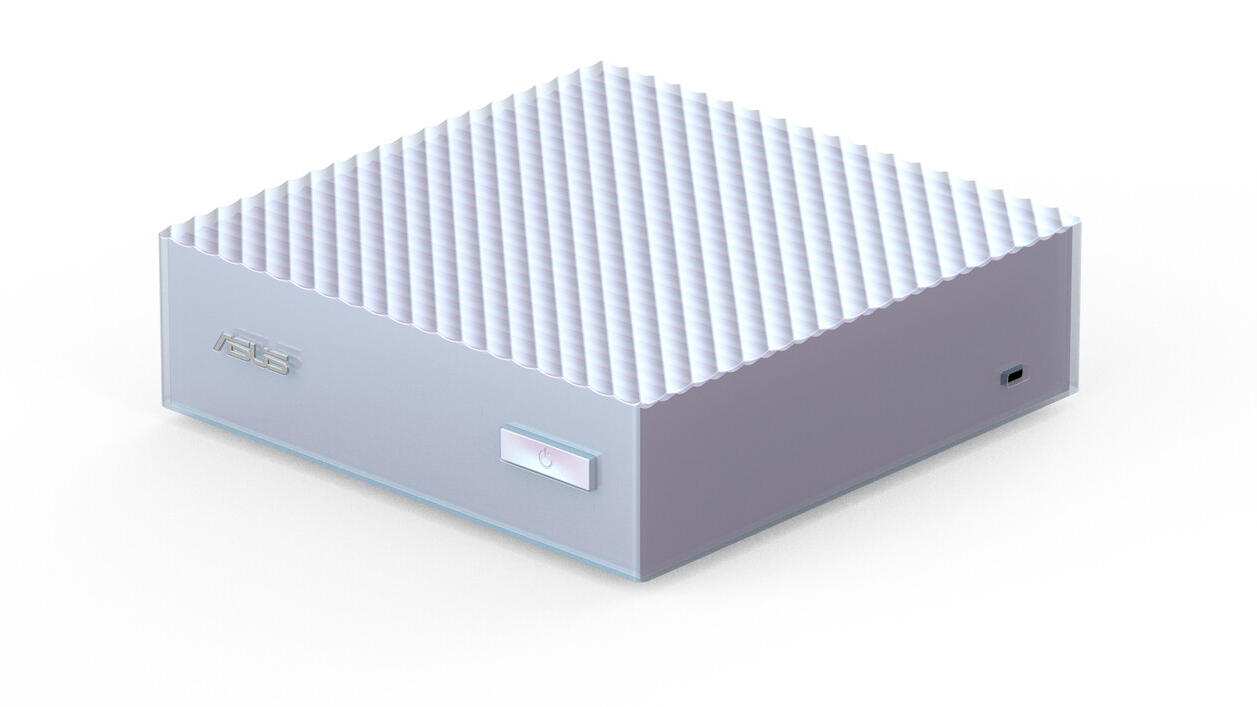
Asus has lifted the curtains of the Ascent GX10, the company's rendition of Nvidia's Project Digits, at GTC 2025. Leveraging the chipmaker's GB10 Grace Blackwell Superchip, the Ascent GX10 offers up to 1,000 TOPS of AI performance.
Like Project Digits, the Ascent GX10 is a mini-PC that can be placed on your desk. You just need to connect a keyboard, mouse, and monitor to it to have a powerful AI supercomputer at your disposal. Asus hasn't liberated the product page for the Ascent GX10, so all the specifications we have on the mini-PC come from the press release.
The GB10, the heart of the Ascent GX10, combines Nvidia's Grace CPU and Blackwell GPU. However, the GB10 is a shrunk-down version of Nvidia's Grace Blackwell Superchip.
The Grace CPU features a 20-core Arm design comprising 10 Cortex-X925 and 10 Cortex-A725 cores. It is connected to Nvidia's latest Blackwell GPU through a high-performance NVLink-C2C interconnect. In unison, the GB10 delivers up to 1 PFLOP (1,000 TFLOPS) of FP4 performance.
Ascent GX10, Bringing AI Power To Developer's Fingertips
“AI is transforming every industry, and the ASUS Ascent GX10 is designed to bring this transformative power to every developer’s fingertips,” said KuoWei Chao, General Manager of ASUS IoT and NUC Business Group in the press release. “By integrating the NVIDIA Grace Blackwell Superchip, we are providing a powerful yet compact tool that enables developers, data scientists, and AI researchers to innovate and push the boundaries of AI right from their desks.”
The Ascent GX10 also has 128GB of unified system memory, which allows the device to handle AI models with up to 200 billion parameters. While Asus didn't reveal the memory's specifications, it should use the same LPDDR5x as Project Digits and up to 4TB of M.2 NVMe storage with self-encryption.
The device has Nvidia's ConnectX network interface as part of its networking capabilities, meaning you can hook up to Ascend GX10 systems for larger AI models, such as Llama 3.1, which flaunts up to 405 billion parameters.
Stay On the Cutting Edge: Get the Tom's Hardware Newsletter
Get Tom's Hardware's best news and in-depth reviews, straight to your inbox.
Without a product page or additional renders, we can't know for sure what kind of connectivity the Ascend GX10 will offer. For reference, Project Digits has four USB4 Type-C ports, Wi-Fi, an Ethernet port, and one HDMI 2.1a port for the display.
Asus hasn't revealed the Ascent GX10's availability or pricing. Project Digits will hit the market in May, starting at $3,000, and we expect the AScent GX10 to have similar availability and pricing.

Zhiye Liu is a news editor and memory reviewer at Tom’s Hardware. Although he loves everything that’s hardware, he has a soft spot for CPUs, GPUs, and RAM.
-
edzieba ReplyAsus hasn't liberated the product page for the Ascent GX10
Hasn't released the product page. Another GPT article, or just google translate and no editorial oversight? -
kealii123 Reply
its a jokeedzieba said:Hasn't released the product page. Another GPT article, or just google translate and no editorial oversight? -
bit_user Reply
I seem to recall having noticed some unusual word usage by this author, previously. I'm pretty sure it's not due to LLM or probably even automated translation, since one notable characteristic of LLMs is a strong preference for more common words, phrases, and writing structures. They actually tend not to sound quirky.edzieba said:Hasn't released the product page. Another GPT article, or just google translate and no editorial oversight?
I don't usually comment about it, unless it's bad enough to confuse readers or convey a message different than probably intended. Of all my concerns about the content on this site, I'd have to rank English grammar and style near the bottom. As long as the writing is clear enough and not confusing, it's really the information that I care about.
BTW, the complaint I'd have about this article is that it didn't put "supercomputer" in quotes. Someone at Nvidia seems to be stuck back in the 1990's or 2000's and believes everything which fits that ancient definition of a supercomputer can be labelled as one. Even then, I'm pretty sure its fp64 performance is rubbish, so you'd have to qualify it as an AI "supercomputer". -
bit_user Reply
Sorry, what? Where did you get that? I think you're probably looking at vector int8 dot product + accumulate (i.e. DP4A).Mr Majestyk said:For reference, the 5090 has about 208 TOPs @ fp4.
By comparison, its tensor cores can do 419 TOPS @ fp16 (838 with sparsity).
Nvidia claims the RTX 5090 does 1676 tensor TOPS @ fp4 (3352 with sparsity). And we know their GB10 numbers from this article are with sparsity, because Nvidia will always quote the highest number they can possibly justify. -
bit_user Reply
If we're talking native workloads, then I expect Digits would stomp all over it on AI. Digits is made primarily for AI, while Strix Halo sort of stumbled into that niche.usertests said:I want to Project Digits compared against Strix Halo in everything.
In terms of CPU workloads, the X925 cores are way bigger than their predecessors, the X4 cores (yes, Arm switched naming conventions). They were designed to go up against Apple's P-cores. 10 of those bad boys should pack a punch, even though they're only complemented by 10 A725 cores. It will be enough to pull ahead in a lot of things. I'm not sure who would take the overall lead. -
usertests Reply
I haven't seen anything that isn't Nvidia marketing material, so I'll reserve judgment.bit_user said:If we're talking native workloads, then I expect Digits would stomp all over it on AI. Digits is made primarily for AI, while Strix Halo sort of stumbled into that niche.
Comparing the two is obviously of interest due to their similar AI target market, pricing, CPU core counts, and (up to) 128 GB of LPDDR5(X).
If Digits/Spark is stomping Halo by 5-10x or something, maybe Strix Halo pricing needs to come down and Medusa Halo needs to use RDNA4 with big TOPS boosts. Meanwhile, Medusa Point may be stuck at RDNA3.5.
ARM X-cores have lagged behind Apple P-cores. They made big claims about X925 single-threaded uplifts, but Zen 5 cores can easily clock over 30% higher. Strix Halo has 16 to Digits' 10+10 cores. I think it will be similar at best but more software and operating systems will run without issues on x86.bit_user said:10 of those bad boys should pack a punch, even though they're only complemented by 10 A725 cores. It will be enough to pull ahead in a lot of things. I'm not sure who would take the overall lead. -
bit_user Reply
I contend that Strix Halo wasn't primarily designed for AI. Also, it's x86 and a laptop CPU, while GB10 is neither of those things.usertests said:Comparing the two is obviously of interest due to their similar AI target market, pricing, CPU core counts, and (up to) 128 GB of LPDDR5(X).
If Digits/Spark is stomping Halo by 5-10x or something, maybe Strix Halo pricing needs to come down
So, no. The people putting it in mini-PCs are doing so opportunistically. Maybe Digits shrinks the market for such machines, but we so far have no indication that Ryzen AI Max is under threat in its home territory of premium non-dGPU laptops.
Yes. Both for AI/FSR4 and also for ray tracing, AMD needs to push for getting RDNA4 in their laptops. Although, you're probably right that it's too late for the mainstream tier of Zen 6 SoCs.usertests said:Medusa Halo needs to use RDNA4 with big TOPS boosts.
If they can come close to Apple on IPC, then X925 cores will definitely bring some heat to Zen 5.usertests said:ARM X-cores have lagged behind Apple P-cores. They made big claims about X925 single-threaded uplifts, but Zen 5 cores can easily clock over 30% higher.
When Zen 5 can get 32 threads cranking or exploit its AVX-512, I think it should do well. On scalar and more lightly-threaded workloads, I think it's in trouble.usertests said:Strix Halo has 16 to Digits' 10+10 cores. I think it will be similar at best but more software and operating systems will run without issues on x86.